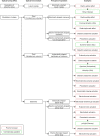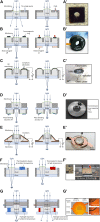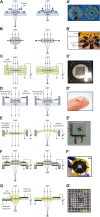Electrically Tunable Lenses: A Review
- PMID: 34179110
- PMCID: PMC8220069
- DOI: 10.3389/frobt.2021.678046
Electrically Tunable Lenses: A Review
Abstract
Optical lenses with electrically controllable focal length are of growing interest, in order to reduce the complexity, size, weight, response time and power consumption of conventional focusing/zooming systems, based on glass lenses displaced by motors. They might become especially relevant for diverse robotic and machine vision-based devices, including cameras not only for portable consumer electronics (e.g. smart phones) and advanced optical instrumentation (e.g. microscopes, endoscopes, etc.), but also for emerging applications like small/micro-payload drones and wearable virtual/augmented-reality systems. This paper reviews the most widely studied strategies to obtain such varifocal "smart lenses", which can electrically be tuned, either directly or via electro-mechanical or electro-thermal coupling. Only technologies that ensure controllable focusing of multi-chromatic light, with spatial continuity (i.e. continuous tunability) in wavefronts and focal lengths, as required for visible-range imaging, are considered. Both encapsulated fluid-based lenses and fully elastomeric lenses are reviewed, ranging from proof-of-concept prototypes to commercially available products. They are classified according to the focus-changing principles of operation, and they are described and compared in terms of advantages and drawbacks. This systematic overview should help to stimulate further developments in the field.
Keywords: deformable; elastomer; electrical; lens; liquid; silicone; soft; tunable.
Copyright © 2021 Chen, Ghilardi, Busfield and Carpi.
Conflict of interest statement
The authors declare that the research was conducted in the absence of any commercial or financial relationships that could be construed as a potential conflict of interest.
Figures








Similar articles
-
An electrically tunable optical zoom system using two composite liquid crystal lenses with a large zoom ratio.Opt Express. 2011 Feb 28;19(5):4714-21. doi: 10.1364/OE.19.004714. Opt Express. 2011. PMID: 21369302
-
Electrically tunable soft solid lens inspired by reptile and bird accommodation.Bioinspir Biomim. 2016 Oct 26;11(6):065003. doi: 10.1088/1748-3190/11/6/065003. Bioinspir Biomim. 2016. PMID: 27783568
-
Tunable Soft Lens of Large Focal Length Change.Soft Robot. 2022 Aug;9(4):705-712. doi: 10.1089/soro.2021.0036. Epub 2021 Aug 12. Soft Robot. 2022. PMID: 34388046
-
Electrically Tunable Lenses for Imaging and Light Manipulation.Micromachines (Basel). 2023 Jan 26;14(2):319. doi: 10.3390/mi14020319. Micromachines (Basel). 2023. PMID: 36838021 Free PMC article. Review.
-
Recent Developments in Optofluidic Lens Technology.Micromachines (Basel). 2016 Jun 10;7(6):102. doi: 10.3390/mi7060102. Micromachines (Basel). 2016. PMID: 30404276 Free PMC article. Review.
Cited by
-
A tunable flat terahertz lens using Dirac semimetals: a simulation study.Sci Rep. 2024 Mar 2;14(1):5191. doi: 10.1038/s41598-024-56026-0. Sci Rep. 2024. PMID: 38431742 Free PMC article.
-
Connected Droplet Shape Analysis for Nanoflow Quantification in Thin Electroosmotic Micropumps and a Tunable Convex Lens Application.Langmuir. 2023 Feb 21;39(7):2569-2578. doi: 10.1021/acs.langmuir.2c02875. Epub 2023 Feb 10. Langmuir. 2023. PMID: 36763988 Free PMC article.
-
Contrast sensitivity is resilient to induced fast periodic defocus oscillations.Biomed Opt Express. 2024 May 20;15(6):3848-3858. doi: 10.1364/BOE.521340. eCollection 2024 Jun 1. Biomed Opt Express. 2024. PMID: 38867768 Free PMC article.
-
Multibeam continuous axial scanning two-photon microscopy for in vivo volumetric imaging in mouse brain.Biomed Opt Express. 2024 Jan 25;15(2):1089-1101. doi: 10.1364/BOE.514826. eCollection 2024 Feb 1. Biomed Opt Express. 2024. PMID: 38404301 Free PMC article.
-
Optical beam scanner with reconfigurable non-mechanical control of beam position, angle, and focus for low-cost whole-eye OCT imaging.Biomed Opt Express. 2023 Aug 4;14(9):4468-4484. doi: 10.1364/BOE.493917. eCollection 2023 Sep 1. Biomed Opt Express. 2023. PMID: 37791284 Free PMC article.
References
-
- Agarwal M., Gunasekaran R. A., Coane P., Varahramyan K. (2004). Polymer-based Variable Focal Length Microlens System. J. Micromech. Microeng. 14, 1665–1673. 10.1088/0960-1317/14/12/010 - DOI
-
- Allen M. (2014). Liquid crystal Lenses to Make Phones More Efficient. Horizon - the EU Research & Innovation magazine. online.
Publication types
LinkOut - more resources
Full Text Sources
Other Literature Sources

